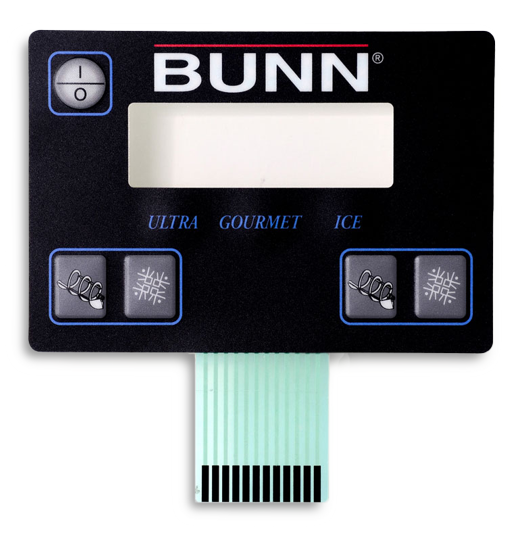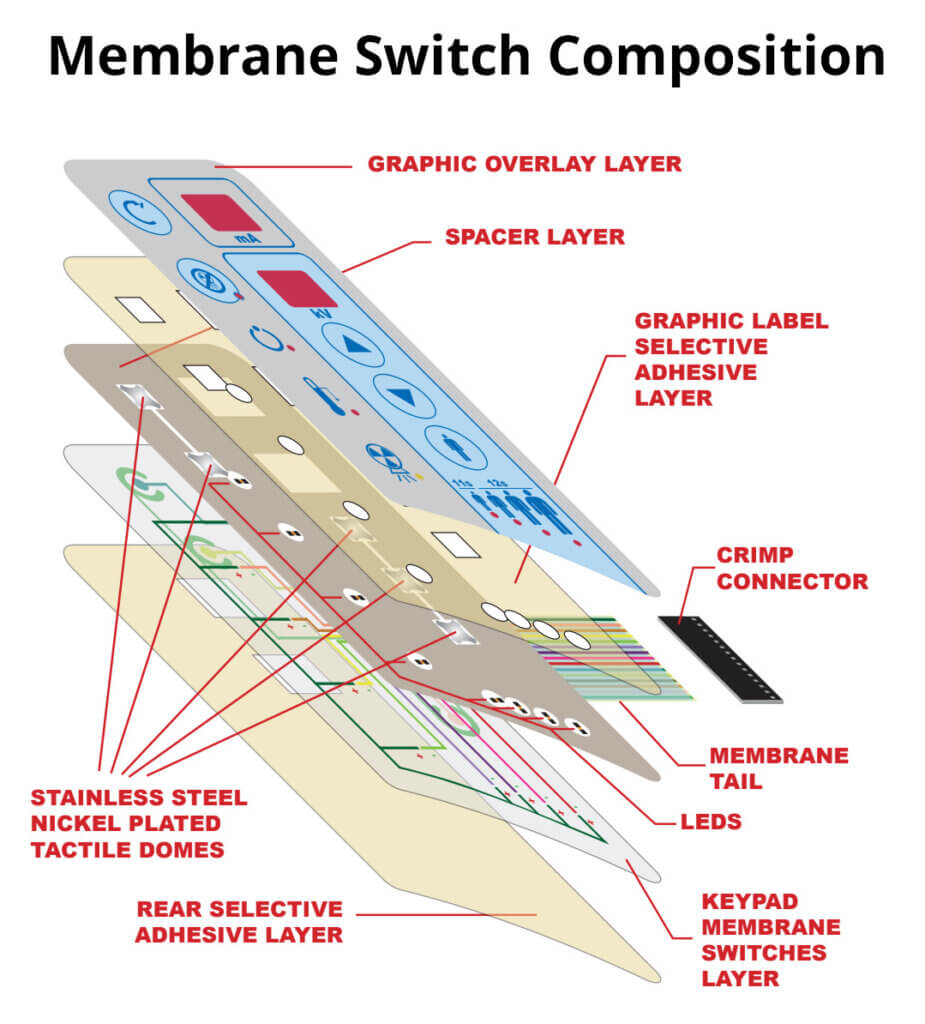Global Membrane Switch Manufacturer with Adaptive Production Options
Global Membrane Switch Manufacturer with Adaptive Production Options
Blog Article
Discovering the Production Refine of Membrane Switch for Various Industries
The production procedure of Membrane buttons is a complicated endeavor that demands accuracy and focus to information. From selecting appropriate products to applying rigorous top quality control actions, each step plays an essential function in ensuring capability. Different industries, consisting of medical and vehicle, rely on these parts for their unique applications. Understanding the details of this process reveals considerable insights right into just how these switches are generated and their impact throughout varied markets.
Understanding Membrane Switches: An Introduction

Key Materials Utilized in Membrane Switch Production
In Membrane button production, the option of vital materials considerably affects functionality and durability. Conductive products, adhesives, and finishings play important duties, while substrate selection affects total performance and integrity. Comprehending these components is crucial for maximizing the style and manufacturing of Membrane switches.
Conductive Materials Overview
Conductive materials play a vital function in the capability of Membrane buttons, making sure dependable electrical connections within the gadget. Commonly used products consist of silver, copper, and carbon-based inks, each offering distinct benefits. Silver is favored for its high conductivity and longevity, making it optimal for applications requiring durable performance. Copper, while somewhat much less conductive than silver, is a cost-efficient alternative frequently utilized in printed circuits. Carbon-based inks give a versatile option, appropriate for applications where adaptability and reduced expenses are prioritized, although they have actually reduced conductivity compared to metal options. The option of conductive products straight influences the overall integrity, life-span, and performance of the Membrane button, making it an essential factor to consider in the production process.
Adhesives and Coatings
Finishings and adhesives are necessary parts in the manufacturing of Membrane switches, offering important bonding and protective homes. These materials ensure that different layers of the button, consisting of visuals overlays and circuitry, stick securely to one another, enhancing resilience and functionality. Commonly made use of adhesives consist of pressure-sensitive adhesives (PSAs) and epoxy-based formulas, which provide strong attachment and strength. Coatings, such as polyurethane or acrylic, serve to safeguard versus ecological elements, consisting of wetness, abrasion, and chemicals. In addition, finishes can improve responsive feedback and visual allure, adding to the general user experience. The selection of proper adhesives and finishings is crucial for enhancing efficiency and longevity in diverse applications across various sectors, ensuring that Membrane changes fulfill particular functional demands.
Substratum Selection Aspects
Substrate option plays an important duty in the manufacturing of Membrane buttons, as it significantly affects their overall efficiency and resilience. Trick materials such as polyester, polycarbonate, and flexible published circuit card (FPCBs) are generally made use of for their distinctive homes. Polyester is favored for its cost-effectiveness and resistance to abrasion, making it ideal for applications with high wear. Polycarbonate offers superior quality and effect resistance, perfect for atmospheres requiring high presence. FPCBs supply boosted versatility and are often made use of in complex layouts. The choice of substratum also impacts variables like thermal stability, chemical resistance, and simplicity of printing. Inevitably, picking the suitable substrate is vital for making certain the functionality and longevity of Membrane switches across numerous sectors.
The Design Process of Membrane Changes
The design procedure of Membrane switches is a crucial phase that substantially influences the capability and aesthetics of the end product - membrane switch manufacturer. It starts with defining the particular needs of the application, consisting of measurements, switch design, and tactile feedback preferences. Designers should take into consideration user interaction, making sure that the button is intuitive and accessible.Next, materials are chosen based on durability, versatility, and ecological resistance. The integration of graphics and branding elements is likewise essential, as it boosts aesthetic charm and communication. Prototyping permits iterative testing, allowing modifications based upon customer comments and efficiency evaluations.Additionally, the design must account for the electric parts, such as circuits and connectors, ensuring dependability and ease of usage. Inevitably, an effective style integrates functionality, aesthetic appeals, and user experience, leading the way for effective production and durable performance in various industries
Printing Strategies for Membrane Switches Over
The printing strategies used in Membrane button manufacturing play an important function in figuring out the end product's quality and functionality. Screen printing supplies benefits such as sturdiness and vibrant shade application, while digital printing innovations supply versatility and precision in design. Comprehending these methods can substantially affect the general effectiveness of Membrane switches in numerous applications.
Display Printing Advantages
Many advantages make display publishing a preferred method for producing Membrane buttons. This technique find this allows for high-grade, in-depth styles and dynamic shades, which are important for interface applications. Display printing is especially reliable for using thick ink layers, improving resilience and responsive responses. Furthermore, it supplies superb adhesion to numerous substratums, making certain durability sought after atmospheres. The process is economical for big manufacturing runs, as it minimizes configuration time and waste. Screen printing supports a vast array of inks, including specialty and UV-curable choices, enabling convenience in layout. Its capability to create regular results across multiple devices makes it a trustworthy selection for producers going for quality and efficiency in Membrane button production.
Digital Printing Innovations

Innovations in digital printing modern technology are transforming the production of Membrane switches, supplying makers ingenious solutions that boost style versatility and performance. Digital printing enables high-resolution graphics and elaborate designs, making it possible for custom-made branding and performance without the constraints of traditional techniques. This technique minimizes setup times and expenses, assisting in shorter production runs and very little waste, making it ideal for services with differing demands. In addition, developments in ink formulas supply far better sturdiness and attachment, making certain durability in different settings. As markets increasingly seek complicated and personalized styles, electronic printing stands apart as an essential method, setting a brand-new standard in Membrane button production. The integration of these developments placements makers to meet progressing market requires properly.
Setting up and Layering of Membrane Switch Components
Careful assembly and layering of Membrane switch parts are important to ensuring functionality and resilience. This process starts with the specific positioning of different layers, including the graphic overlay, sticky, circuit layer, and support product. Each part must be meticulously positioned to keep electric stability and customer interface responsiveness.During setting up, conductive traces are related to the circuit layer, normally made from materials like polyester or polycarbonate. This layer is crucial, as it beams when stress is used. The sticky utilized for bonding these layers is also chosen for its ability to endure ecological stress and anxieties while keeping a safe bond.Heat and pressure are commonly applied during the setting up process to identify that the layers adhere appropriately without jeopardizing the performance of the switch. Finally, focus is given to the side securing to secure versus moisture and impurities, protecting the longevity of the Membrane button in numerous commercial applications.
Top Quality Control Actions in Membrane Switch Production
Quality control actions play a necessary role in guaranteeing the dependability and efficiency of Membrane changes following the assembly and layering of their parts. In the production process, numerous essential assessments are conducted to maintain quality requirements. These consist of aesthetic evaluations for issues in printing and adhesive application, in addition to useful tests to verify the responsiveness of each switch.Additionally, ecological screening is performed to evaluate the buttons' resilience versus temperature level fluctuations and humidity direct exposure. Producers often execute analytical procedure control (copyright) techniques to keep track of production uniformity, making it possible for early detection of anomalies.Furthermore, traceability systems are developed to track products and parts, making browse around this site certain accountability and promoting recalls if required. Calibration of devices and adherence to sector standards are likewise crucial to keeping item honesty. Jointly, these top quality control actions safeguard the efficiency of Membrane switches over throughout various applications, ultimately enhancing consumer contentment.
Applications of Membrane Switches Throughout Different Industries
Membrane switches are made use of throughout a varied range of markets, showcasing their convenience and versatility. In the medical sector, they provide waterproof and dependable user interfaces for tools such as analysis equipment and mixture pumps, making certain hygiene and ease of usage. The auto market employs Membrane switches for control panel controls, allowing seamless communication in between the chauffeur and vehicle systems.In customer electronics, these buttons are discovered in appliances and portable gadgets, providing a sleek, modern-day aesthetic while enhancing performance. Industrial applications also leverage Membrane switches for equipment control board, where toughness and resistance to severe conditions are essential.Furthermore, the aerospace and protection sectors make use of Membrane switches for cockpit instrumentation and communication systems, focusing on integrity and Home Page efficiency under extreme problems. In general, Membrane buttons play an important duty in boosting the user experience and operational efficiency throughout numerous domain names.
Regularly Asked Inquiries
For how long Does It Take to Produce a Membrane Layer Switch?
The manufacturing time for a membrane layer switch usually ranges from a few days to a number of weeks - membrane switch manufacturer. Elements affecting this duration include layout complexity, product availability, and production volume, all influencing the overall timeline markedly
What Is the Common Life-span of a Membrane Layer Switch?
The normal life-span of a membrane switch typically varies from 1 to 5 million actuations, relying on aspects such as material high quality, ecological conditions, and usage frequency, substantially affecting longevity and overall efficiency.
Can Membrane Switches Be Custom-made for Details Applications?
Membrane buttons can certainly be tailored for details applications. Their design flexibility permits changes in size, shape, colors, and graphics, guaranteeing compatibility with one-of-a-kind needs throughout various industries and enhancing performance and individual experience.

Are Membrane Switches Over Environmentally Pleasant?
The environmental effect of Membrane switches over varies. Some products used may not be environmentally friendly, while developments in making processes are progressively concentrating on sustainability, aiming to decrease waste and advertise recyclable elements in their production.
What Are the Usual Failing Modes of Membrane Switches?
Typical failing modes of Membrane buttons consist of delamination, glue failing, damage from usage, moisture ingress, and electric failings. These issues can significantly impact functionality, efficiency, and lifespan in numerous applications across different industries. Membrane switches can be personalized to fit particular style needs, such as dimension, form, and capability, making them highly adaptable.The construction commonly entails numerous layers, consisting of a visuals overlay, adhesive, and a circuit layer, which work with each other to create a seamless user experience. In Membrane switch manufacturing, the option of key products substantially influences performance and sturdiness. The automotive market utilizes Membrane switches for control panel controls, enabling smooth interaction between the vehicle driver and lorry systems.In consumer electronic devices, these switches are found in home appliances and handheld devices, supplying a sleek, modern-day aesthetic while boosting functionality. Industrial applications also leverage Membrane switches for machinery control panels, where sturdiness and resistance to extreme problems are essential.Furthermore, the aerospace and protection fields use Membrane buttons for cockpit instrumentation and communication systems, prioritizing reliability and performance under extreme conditions. Membrane switches can indeed be tailored for details applications.
Report this page